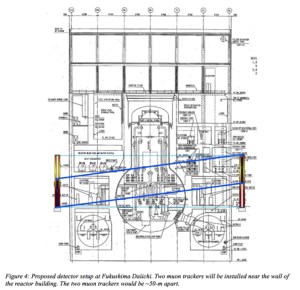Peter Lobner, updated 4 March 2023
Introduction
A muon is an unstable elementary subatomic particle in the same class as an electron (they’re both leptons), but with a much greater mass (207 times greater). A useful property of muons is that they can penetrate matter much further than X-rays with the added benefit of causing essentially zero damage to the matter it passes through. Muons scatter and lose energy as they pass through matter, slowing down and eventually decaying, typically into three particles: an electron and two types of neutrinos. The higher the average density of the matter encountered along the muon’s flight path, the more quickly the muon slows down.
Muons are created by the interaction of high-energy cosmic rays with the upper regions of Earth’s atmosphere and they account for much of the cosmic radiation that reaches the Earth’s surface. This means that the existing flux of muon radiation at the Earth’s surface (about 10,000 muons/square meter/sec) is a free resource for clever researchers.
Muon tomography uses this free muon flux and the muon’s characteristic of slowing down more quickly in denser matter to create a density map of the field-of-view available to a muon detector. There are two types of muon imaging, transmission and scattering. The differences are addressed in LA-UR-15-24802, listed below. In both types of muon imaging, denser objects and structures in the detectors field of view appear as shadows (muon shadows) that are darker (fewer muons getting thru to the detectors) than less dense areas.
Muon tomography at the Fukushima Nuclear Power Plant
Tokyo Electric Power Company (TEPCO) supported the use of muon tomography at the Fukushima Nuclear Power Plant to help determine what damage was done to the reactor cores at Units 1, 2 and 3 during the 11 March 2011 accident, which was precipitated by a 9.0 magnitude earthquake followed by a 15-meter (49.2-ft) tsunami.
A 2013 muon tomography feasibility study (Hauro Miyadera, et al.) reported: “Muon scattering imaging has high sensitivity for detecting uranium fuel and debris even through thick concrete walls and a reactor pressure vessel. Technical demonstrations using a reactor mockup, a detector radiation test at Fukushima Daiichi, and simulation studies have been carried out. These studies establish feasibility for the reactor imaging. A few months of measurement will reveal the spatial distribution of the reactor fuel.”
At Reactor #1, two 22 ton (20 metric ton), 21-foot by 21-foot (6.4 m by 6.4 m) muon detectors were installed and used to collect data over periods of months to develop high-resolution images of the damaged reactor core and surrounding areas. Placement of the muon detectors and the general scan geometry is shown in the following diagram.
Source: LA-UR-12-20494
Reactor #1 muon scan results
In March 2015, TEPCO announced that its muon tomography scanning efforts at Fukushima were successful, and confirmed that the nuclear plant’s Reactor #1 suffered a complete meltdown. The muon scans showed no corium (i.e., the lava-like product of a reactor core meltdown containing the melted nuclear fuel, fission products, control rods, and structural materials) remained in the reactor pressure vessel (RPV). The muon scans did not show the distribution of the corium that flowed out of the bottom of the reactor vessel into the primary containment vessel (PCV).
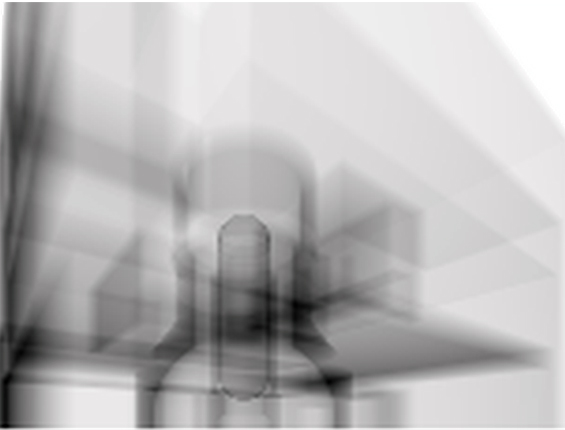
RPV, should have been visible as a dark shadow inside the RPV.
Source: TEPCO via ExtremeTech (2015)
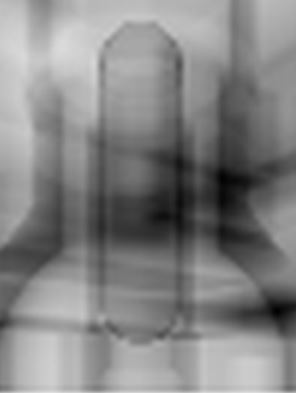
Source: TEPCO via ExtremeTech (2015)
Reactor #2 muon scan results
World Nuclear News (WNN) reported (2016 & 2017), “TEPCO said analysis of muon examinations of the fuel debris shows that most of the fuel has melted and dropped from its original position within the core (and resolidified)…..Measurements taken between March and July 2016 at unit 2 showed high-density materials, considered to be fuel debris, in the lower area of the RPV.”
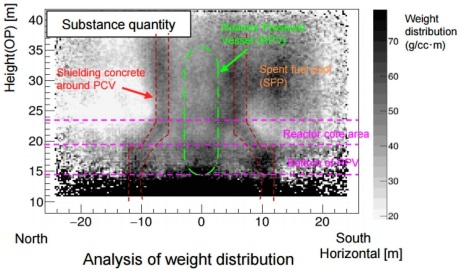
Source: TEPCO via WNN (2016)
Reactor #3 muon scan results
In 2017, WNN reported, “Some of the fuel in the damaged unit 3 of the Fukushima Daiichi plant has melted and dropped into the primary containment vessel, initial results from using a muon detection system indicate. Part of the fuel, however, is believed to remain in the reactor pressure vessel.”
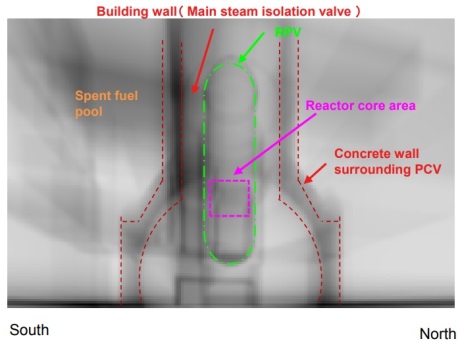
Source: TEPCO via WNN (2017)
Summary of fuel debris status at Fukushima
Based on the results of the muon tomography program and other means of investigation, TEPCO created the following graphic summary showing the estimated distribution of core and containment vessel fuel debris in Fukushima Units 1, 2 & 3.
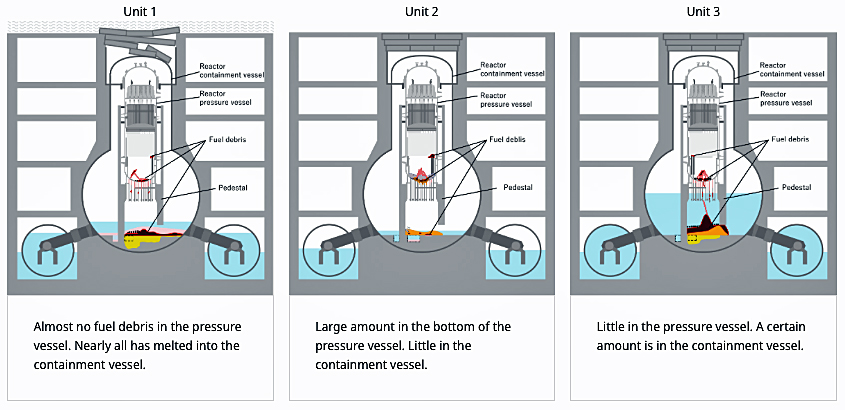
For more information
- Hauro Miyadera, et al., “Imaging Fukushima Daiichi reactors with muons,” published in AIP Advances, published online 24 May 2013: https://aip.scitation.org/doi/10.1063/1.4808210
- Fukushima Daiichi NPS Prompt Report (Feb 09, 2015) – Recent topics: Cosmic “muon” rays to look inside Fukushima reactors as TEPCO begins testing,” TEPCO, 9 February 2015: https://www.tepco.co.jp/en/press/corp-com/release/2015/1248057_6844.html
- “Muon Tomography – Imaging the core of Fukushima reactors with muons,” LA-UR-15-24802, Los Alamos National Laboratory, 2015: https://www.lanl.gov/org/ddste/aldps/physics/_assets/docs/muon-tomography.pdf
- Graham Templeton, “Scientists Are Using Cosmic Radiation To Peer Inside Fukushima’s Mangled Reactor,” Motherboard, 2 March 2015: https://www.vice.com/en/article/kbzk89/scientists-are-using-cosmic-radiation-to-peer-inside-fukushimas-mangled-reactor
- Haruo Miyadera, et al., “Our Next Two Steps for Fukushima Daiichi Muon Tomography”, LA-UR-12-20494, Los Alamos National Laboratory, 2015:https://permalink.lanl.gov/object/tr?what=info:lanl-repo/lareport/LA-UR-12-20494
- “Muon Scan Finds No Fuel In Fukushima Unit 1 Reactor Vessel,” SimplifyInfo.org, 19 March 2015: https://simplyinfo.org/2015/03/muon-scan-finds-no-fuel-in-fukushima-unit-1-reactor-vessel/
- Joel Hruska, “Muon scans confirm complete reactor meltdown at Fukushima Reactor #1,” ExtremeTech, 20 March 2015: https://www.extremetech.com/extreme/201706-muon-scans-confirm-complete-reactor-meltdown-at-fukushima-reactor-1
- “Detectors confirm most fuel remains in unit 2 vessel,” World Nuclear News, 29 July 2016: https://world-nuclear-news.org/Articles/Detectors-confirm-most-fuel-remains-in-unit-2-vess
- “Muons suggest location of fuel in unit 3,” World Nuclear News, 2 October 2017: https://www.world-nuclear-news.org/RS-Muons-suggest-location-of-fuel-in-unit-3-0210174.html
- “The Status of Fuel Debris Retrieval,” TEPCO: https://www.tepco.co.jp/en/hd/decommission/progress/retrieval/index-e.html
- David Adams, “Muography offers a new way to see inside a multitude of objects,” PNAS, Vol. 118, No. 14, 31 March 2021: https://www.pnas.org/doi/10.1073/pnas.2104652118
